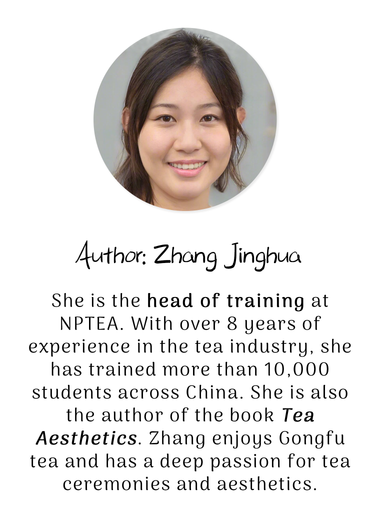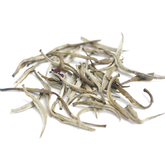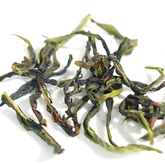How to Make Loose Leaf Tea: A Beginner’s Guide to Brewing Chinese Tea | NPTEA
If you think making tea is just putting a teabag in hot water, it's time to get reacquainted with Chinese loose leaf tea—its brewing method is completely different from tea bags, and so is the flavor.
Many people might worry that brewing loose leaf tea is complicated, requiring professional gongfu teaware like a Gaiwan, Zisha teapot. The truth is, it doesn't! Whether you only have a mug, a glass pot, or even a French press with a filter, there's a method to brew a great cup.

As a Chinese tea master, I’ve trained over a thousand people to love and master tea. This article will teach you how to brew loose leaf tea, offering easy and flexible methods based on the tools you have. Whether you are a total beginner or looking to upgrade your experience, you'll find a method here for you.
What is Loose Leaf Tea?
Simply put, loose leaf tea is tea sold in the form of whole or larger leaf pieces. It’s not like teabags , which are often filled with cut-up tea dust. When you open a bag of genuine loose leaf tea from China, you'll see beautiful, intact leaves, buds, or stems. The leaves’ natural form and aroma are preserved.
Loose leaf tea and teabags have fundamental differences in taste, aroma, and quality. Imagine a whole apple (loose leaf tea) versus applesauce made from ground-up apples (teabags). The former offers more complex layers of flavor, resulting in a smoother, richer, and more nuanced taste.
 For example, a high-quality Phoenix Dancong oolong tea can brew with a natural orchid or peach fragrance. In contrast, teabags, made from tea fannings, can easily turn bitter, and their aroma is often dull or even tainted by the paper bag itself. This is why many people ask is loose leaf tea better than tea bags? The answer is generally yes.
For example, a high-quality Phoenix Dancong oolong tea can brew with a natural orchid or peach fragrance. In contrast, teabags, made from tea fannings, can easily turn bitter, and their aroma is often dull or even tainted by the paper bag itself. This is why many people ask is loose leaf tea better than tea bags? The answer is generally yes.
The Basics of Brewing Great Loose Leaf Tea
To brew a delicious cup of loose leaf tea, the right tools and methods are important, but you also need to master a few core fundamentals. Grasping these will ensure you maximize the tea's flavor, no matter how you choose to brew.
The quality of the tea is key: The starting point for brewing is always the tea itself. Try to choose fresh, whole leaves, and avoid expired or heavily oxidized tea. Especially avoid tea fannings, which can easily make the tea bitter due to their rapid infusion rate. Additionally, tea harvested in the summer is often lower quality. While cheaper, its flavor is often weak and it can turn bitter easily.
Water quality is vital: The quality of your water directly impacts the taste of your tea. We highly recommend using filtered water or natural spring water. Avoid tap water with a high chlorine content, as its chemical taste will completely destroy the tea's aroma. Similarly, hard water's minerals can react with the tea, making the liquor cloudy and affecting its clarity.
Water temperature is the flavor switch: Different teas need different water temperatures. Simply put, water that is too hot can "burn" delicate leaves, leading to bitterness, while water that is too cool won't fully extract the aroma and flavor compounds.
The tea-to-water ratio and steeping time: These are critical for controlling the strength of your tea. For a stronger brew, use more tea; for a lighter brew, use less. At the same time, you must control the steeping time. Too short, and the flavor won't be fully extracted; too long, and the tea will become overly strong and bitter. You need to find the perfect balance through practice.
What If You Don't Have Gongfu Teaware?
You might often see Chinese tea rooms using gongfu teaware, which is indeed the best for brewing. However, this absolutely does not mean you can't enjoy great Chinese loose leaf tea. For beginners and everyday use, there are two simple and effective methods that can help you brew a great cup. This is especially helpful if you're wondering how to brew loose leaf tea without an infuser.(Expand Reading: Essential Chinese Teaware for Every Beginner )
Method 1: The Mug or Glass Cup Method
This method is best for teas with a lighter character, such as green tea, white tea, or Jasmine tea. Just add a small amount of tea leaves (about 1-2 grams) to your mug, pour in hot water, and wait a few minutes. When the leaves start to unfurl and the aroma emerges, you can drink it. Adding more water promptly can prevent the tea from becoming too strong and bitter.

However, note that this method isn't suitable for all teas. For example, oolong teas (like Phoenix Dancong or Tieguanyin) or dark teas (like aged Pu-erh) are not recommended for direct brewing in a glass cup, as they can become intensely bitter if steeped for too long. For these teas, you must separate the leaves from the liquor.
Method 2: Glass Teapot with an Infuser & French Press
This is a very practical alternative that combines convenience with flavor control. A glass teapot with an infuser can effectively solve the problem of separating the leaves from the tea liquor. When you use this teapot, just place the leaves in the infuser, and after the appropriate steeping time, lift it out.

This method effectively prevents bitterness from over-steeping and allows you to control the tea's strength. While it may not offer the same nuanced flavor as gongfu teaware, it's an excellent entry point to enjoying loose leaf tea.
The Best Teaware for Brewing Loose Leaf Tea
To experience the best flavor from loose leaf tea, gongfu teaware is undoubtedly the top choice. In China, almost all serious tea lovers use a Gaiwan or a Zisha teapot because they allow for flexible control over steeping time, maximizing the tea's aroma and flavor.(Expand Reading: A Beginner's Guide to Traditional Chinese KungFu Cha )

A standard set of gongfu teaware usually includes a Gaiwan or Zisha teapot, a fairness pitcher, tasting cups, a filter, and a tea tray. For beginners, however, the most basic setup only requires a Gaiwan and a single cup. There’s no need for a complete set, as this is sufficient to meet your brewing needs while keeping costs down.
A Brewing Guide for Different Loose Leaf Teas
Chinese loose leaf tea is rich and diverse, covering six main categories. Because of their different production processes, each tea has distinct requirements for water temperature, tea-to-water ratio, and steeping time. The following guide, designed for gongfu teaware, will help you brew delicious tea at home, just like in a traditional Chinese tea room.
Green Tea
Tea-to-Water Ratio: 1:20 (1g of tea per 20ml of water)
Water Temperature: 175-185°F (80-85°C)
First Steep Time: 15-20 seconds
Notes: Green tea is delicate and doesn't handle high temperatures well. Water that is too hot will "burn" the leaves, causing bitterness.
White Tea
Tea-to-Water Ratio: 1:15 (1g of tea per 15ml of water)
Water Temperature: 185-195°F (85-90°C)
First Steep Time: 20-30 seconds
Notes: White tea is very durable, especially aged white tea. Young tea is sweet and refreshing; aged tea is rich and mellow. You can extend the steeping time with each successive brew. Aged white tea can even be boiled.

Yellow Tea
Tea-to-Water Ratio: 1:20 (1g of tea per 20ml of water)
Water Temperature: 175-185°F (80-85°C)
First Steep Time: 15-20 seconds
Notes: Yellow tea's brewing is similar to green tea; the water temperature shouldn't be too high. Brewing it allows you to appreciate its unique "yellow liquor and yellow leaves."
Oolong Tea
Tea-to-Water Ratio: 1:15 (1g of tea per 15ml of water)
Water Temperature: 205-212°F (95-100°C)
First Steep Time: 5-10 seconds
Notes: Oolong tea, with its twisted or balled shape, requires high heat to unfurl and release its aroma. High-aroma oolongs benefit from quick steeps to prevent bitterness. This is a key step in how to steep loose leaf tea.
Black Tea
Tea-to-Water Ratio: 1:20 (1g of tea per 20ml of water)
Water Temperature: 175-185°F (80-85°C)
First Steep Time: 5-10 seconds
Notes: For high-quality Chinese black tea, avoid using water that is too hot. A slightly lower temperature can better highlight the tea's sweet and mellow character. This is the best way how to prepare black tea.
Dark Tea
Tea-to-Water Ratio: 1:12 (1g of tea per 12ml of water)
Water Temperature: 212°F (100°C)
First Steep Time: 15-20 seconds (after a quick rinse)
Notes: Dark teas (like Pu-erh) require boiling water to "wake up." The first steep is usually a quick rinse. A Zisha teapot is recommended to enhance its rich and smooth mouthfeel.
Common Brewing Mistakes to Avoid
In addition to mastering the correct brewing methods, avoiding common mistakes is just as important. Here are a few errors beginners often make when learning how to use loose leaf tea.
Using boiling water for all teas
Actually, not all teas are suitable for brewing with 212°F (100°C) water. For example, delicate green tea and Jasmine tea will be "burnt" by boiling water, making the tea unbearably bitter. Also, boiling water may not fully bring out the sweet, mellow notes of high-quality Chinese black tea; a slightly lower temperature sometimes better highlights its soft character.
Steeping for too long
Many people are accustomed to letting tea steep for a long time, but this is the primary cause of bitterness. For teas like roasted oolong, which are rich in compounds, over-steeping will extract too much, making the tea strong and unpleasant to drink.
Using a thermos for long-term steeping
Most loose leaf teas are not suitable for long-term steeping in a thermos. Keeping tea in a thermos is like "stewing" it in a continuous high-temperature environment. This causes a massive release of bitter compounds, completely ruining the tea's intended aroma and flavor.
Summary of Brewing Loose Leaf Tea
Loose leaf tea represents the highest quality of tea and isn't just something to be enjoyed in a Chinese tea room. For beginners, even without professional gongfu teaware, you can use a simple mug or a teapot with an infuser to brew an excellent cup of tea.
Because of its whole leaves, loose leaf tea offers a better taste and aroma than teabags. Starting to experiment with loose leaf tea is a direct way to upgrade your daily tea-drinking experience. So, don't be intimidated by the term "gongfu tea."
Choose a Chinese loose leaf tea that interests you—like a beginner-friendly Jasmine tea or a white tea —and try brewing it with the tools you have on hand. You'll be amazed by the new experience that a single sip can bring.
FAQs About Loose Leaf Tea
Q1: How do you brew loose leaf tea?
A: Use a teapot or mug with an infuser. If you don’t have one, you can brew directly in your cup, but be careful not to use too many leaves to avoid bitterness.
Q2: How much loose leaf tea per cup?
A: A good starting point is 1-2 teaspoons per 8 oz (240ml) cup. You can adjust this to your taste.
Q3: How long does loose leaf tea last? Does it expire?
A: Yes, it expires. When stored properly, it lasts 1-2 years. Green teas are best consumed within a year, while oolongs and dark teas last longer.
Q4: Is loose leaf tea better?
A: Yes. Loose leaf tea uses whole leaves, giving it a more complex flavor and smoother taste. Teabags often use broken leaves, which can easily become bitter.
Q5: Can you reuse loose leaf tea leaves?
A: Yes. Many high-quality loose leaf teas can be re-steeped multiple times, with each brew offering a slightly different flavor.
A: A: Keep it in a cool, dark, and dry place. Use an airtight container to protect it from heat, light, air, and moisture.
A: Yes, most loose leaf tea have a shelf life and should be consumed for the best flavor. However, white tea and dark tea are exceptions; they can be stored long-term and often gain value as they age.
SEE MORE ABOUT TEA
If you are a beginner about Chinese tea:
Basic-Guide-to-Chinese-Tea
If you have questions about selecting tea:
Learn-more-about-chinese-tea
If you have questions about the benefits of tea:
Health-benefits-of-chinese-tea
If you have questions about brewing tea:
How-to-brew-loose-leaf-tea






